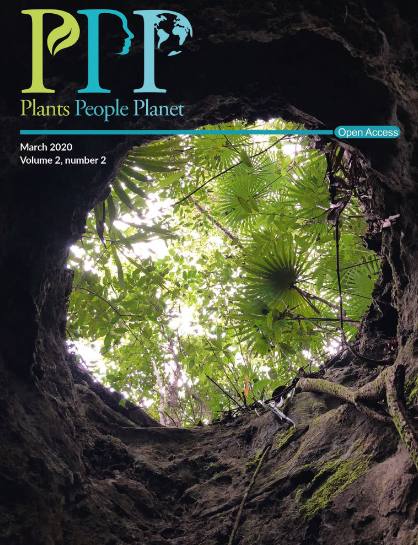Fluctuating selection and rapid evolution of oaks during recent climatic transitions
IF 3.6
2区 环境科学与生态学
Q1 BIODIVERSITY CONSERVATION
引用次数: 1
Abstract
The rapidity of evolutionary changes in trees and whether this pace is sufficient to cope with ongoing climatic change are hotly debated issues in ecology today. Climate warming began in the mid‐19th century, after the Little Ice Age (LIA). Monitoring temporal genetic changes during this climatic transition in multicentennial oak populations revealed evidence of fluctuating selection and rapid evolution. These findings suggest that rapid evolution is probably also currently underway. They may lead to management options for operational forestry aiming to stimulate evolutionary mechanisms during the renewal of oak stands and to decrease potential temporal gene flow. Retrospective studies of the evolutionary responses of tree populations to past documented climate change can provide insight into the adaptive responses of these organisms to ongoing environmental changes. We used a retrospective approach to monitor genetic changes over time in multicentennial sessile oak (Quercus petraea L.) forests. We compared the offspring of three age‐structured cohorts (340, 170, and 60 years old, dating from about 1680, 1850, and 1960) spanning the late Little Ice Age and early Anthropocene. The experiment was repeated in three different forests in western France. The offspring were raised in a common garden experiment, with 30 to 53 open‐pollinated families per cohort. We assessed 16 phenotypic traits in the common garden and observed significant shifts between cohorts for growth and phenology‐related traits. These shifts were correlated with differences in the prevailing temperatures in the past and could be interpreted as temporal genetic changes. However, there was no temporal trend for genetic variation. The genetic changes between the cold (late Little Ice Age) and warm (early Anthropocene) periods were mostly opposite for growth and phenology‐related traits. These findings highlight fluctuations of selection and a rapid evolutionary response of tree populations to climatic transitions in the past, suggesting that similar trends may be at work now. We discuss these results in terms of the mode and direction of evolution, and their potential implications for the adaptive management of oak forests.在最近的气候变化中,橡树的波动选择和快速进化
树木进化变化的速度以及这种速度是否足以应对持续的气候变化,是当今生态学中备受争议的问题。气候变暖始于19世纪中期,即小冰期(LIA)之后。在这一气候转变过程中,对多年期橡树种群的时间遗传变化进行监测,揭示了波动选择和快速进化的证据。这些发现表明,快速进化可能也正在进行中。它们可能导致经营性林业的管理选择,旨在刺激橡树林更新过程中的进化机制,并减少潜在的时间基因流动。对树木种群对过去记录的气候变化的进化反应进行回顾性研究,可以深入了解这些生物对持续环境变化的适应性反应。我们使用了一种回顾性方法来监测多年无柄栎(Quercus petraea L.)森林中随时间的遗传变化。我们比较了三个年龄结构队列(340、170和60)的后代 年代约为1680年、1850年和1960年)。该实验在法国西部的三个不同的森林中重复进行。这些后代是在一个普通的花园实验中饲养的,每个队列有30到53个开放授粉的家庭。我们评估了普通花园中的16个表型性状,并观察到生长和表型相关性状在队列之间的显著变化。这些变化与过去盛行温度的差异有关,可以解释为时间遗传变化。然而,遗传变异没有时间趋势。寒冷时期(小冰期晚期)和温暖时期(人类世早期)之间的遗传变化在生长和表型相关性状方面大多相反。这些发现突显了过去树木种群对气候变化的选择波动和快速进化反应,表明类似的趋势现在可能正在发挥作用。我们从进化模式和方向的角度讨论了这些结果,以及它们对橡树林适应性管理的潜在影响。
本文章由计算机程序翻译,如有差异,请以英文原文为准。
求助全文
约1分钟内获得全文
求助全文
来源期刊

Plants People Planet
Multiple-
CiteScore
9.90
自引率
5.90%
发文量
81
审稿时长
12 weeks
期刊介绍:
Plants, People, Planet aims to publish outstanding research across the plant sciences, placing it firmly within the context of its wider relevance to people, society and the planet. We encourage scientists to consider carefully the potential impact of their research on people’s daily lives, on society, and on the world in which we live. We welcome submissions from all areas of plant sciences, from ecosystem studies to molecular genetics, and particularly encourage interdisciplinary studies, for instance within the social and medical sciences and chemistry and engineering.
 求助内容:
求助内容: 应助结果提醒方式:
应助结果提醒方式:


